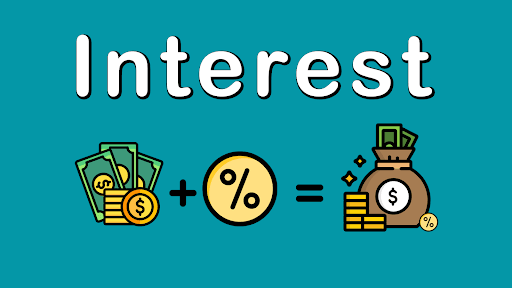
Economics runs the world today. Every part of our lives is affected by economics, from the moment we buy a product to the moment we invest in a business.
Like an invisible thread, interest is a crucial part of economics which binds our economy together. Interest facilitates investments, increases wealth, and stabilizes the economy. An economy relies on interest to promote progress and growth in society.
In this article, we will look into the basic understanding of interest, its various types, and its implications.
What is Interest?
Like a two-way street, interest is the price one pays for borrowing money or the cost one charges for lending money.
According to Investopedia, “Interest is the amount of money a lender or financial institution receives for lending money. Interest can also refer to the amount of ownership a stockholder has in a company,” often expressed in percentages.
Let’s take an example. A person goes to a bank and borrows $2,000 at an interest rate of 10 percent per year. In this case, the person must pay $200 annually (USD 2,000 × 10%). If the loan is payable in five years, the person will pay $1,000 in interest at the end of the loan period.
History of Interest
The origin of interest dates back to ancient times, from old Sumerian documents around 3000 BCE. The records show “the systematic use of credit to loan both grain and metals.”
However, social norms from the Middle Eastern civilizations regarded interest as a sin. For example, the Greek civilization viewed interest as a suspicious activity. Even Aristotle believed that “loans aiming for profit were unnatural and dishonorable.”
Interest became a norm during the Renaissance era because of growing markets and greater mobility of people. Afterward, political philosophers in the 18th and 19th centuries, such as Adam Smith, clarified the economic theories behind interest.
Interest is commonplace today and applied to financial products like car loans, mortgages, credit loans, and personal loans. However, some countries like Pakistan, Iran, and Sudan still practice interest-free banking systems.
Types of Interest
Interest may seem a complex concept, but it generally comes down to three main types: simple (based on principal amount), accrued, and compound (based on principal and previously earned interest).
Here are the three main types of interest:
- Simple (Regular) Interest:
Simple interest, also known as regular interest, is the amount of interest based on the original borrowed amount or principal loan. Simple interest accumulates over time and does not include previously earned interest.
Let’s take an example. Imagine a person borrows $3,000 with a 3 percent interest rate per year; the person would be required to pay $90 in interest per year (USD 3,000 × 3%).
- Accrued Interest:
Accrued interest is the amount accumulating on a loan from a specific date that has yet to be paid out. Interest is accrued usually as a part of a company’s financial statements.
According to Investopedia, “For a borrower, this is interest that is due for payment, but cash has not been remitted to the lender. For a lender, this is interest that has been earned that they have not yet been paid for.”
Let’s take an example. Imagine a company borrows $10,000 from a bank on April 21 at an interest rate of 6 percent per year. If its first interest payment is due in 30 days, the annual interest payment would be $600 (USD 10,000 × 6%), and the monthly interest would be $50 (USD 600 ÷ 12).
If the accounting period ends on May 1, the accumulated interest payment will cover 10 days or $16.67 (USD 50 × 10 ÷ 30).
- Compound Interest:
Unlike simple interest, compound interest does not stay fixed and uses both principal and previously earned interest.
According to Investopedia, “Compound interest is interest on both the principal and the compounding interest paid on that loan.”
For instance, if a person borrows $100,000 at an interest rate of 2 percent and has an accrued interest of $10,000, then the compound interest would be $2,200 (110,000 × 2%).
Implications of Interest
Like a double-edged sword, interest affects almost every aspect of an economy, shapes economic behavior, and impacts financial markets.
Here are some key implications of interest:
- Interest aids in optimizing monetary policy
Banks use interest to control inflation and promote economic growth. Central banks raise interest rates during inflation to discourage people and businesses from overspending. This way, central banks reduce demand for goods and services. Contrarily, central banks can also increase demand for goods and services by dropping interest rates. In this situation, higher interest rates boost borrowing and spending.
In both scenarios, interest enables banks to optimize their monetary policies based on the economic conditions of a society.
- Interest affects consumer decisions
When interest rates fall, consumers generally take out more loans, such as car, house, and student loans. This drop in interest rates leads to economic growth.
However, over-lending can also lead to debt accumulation, which can have drastic drawbacks. One significant example of over-lending is the stock market crash of 1929, which happened when banks extended too much credit, leading to the Great Depression.
- Interest influences investors
Investors generally look for fixed-income investments, such as bonds and certificates of deposit (CDs), when interest rates rise. This approach offers investors a guaranteed return on investment, encouraging them not to take risks associated with stocks.
However, investors turn to stocks and real estate to make more money when interest rates fall. This way, they take risks for higher rewards.
- Interest affects saving and retirement planning
Saving accounts and long-term retirement planning become more attractive to consumers when interest rates rise because higher interest rates offer better interest on money and yield on new bonds.
Contrarily, lower interest rates force consumers to save money and explore alternative options to achieve long-term investment goals.
Conclusion
Interest is vital to an economy, affecting every part of human life. From everyday purchases to long-term investments, people can make informed decisions by understanding interest and its influence on their borrowings, investments, and financial goals and achievements. Like a guardian, interest guides the marketplace, where fortunes are made and lost.
